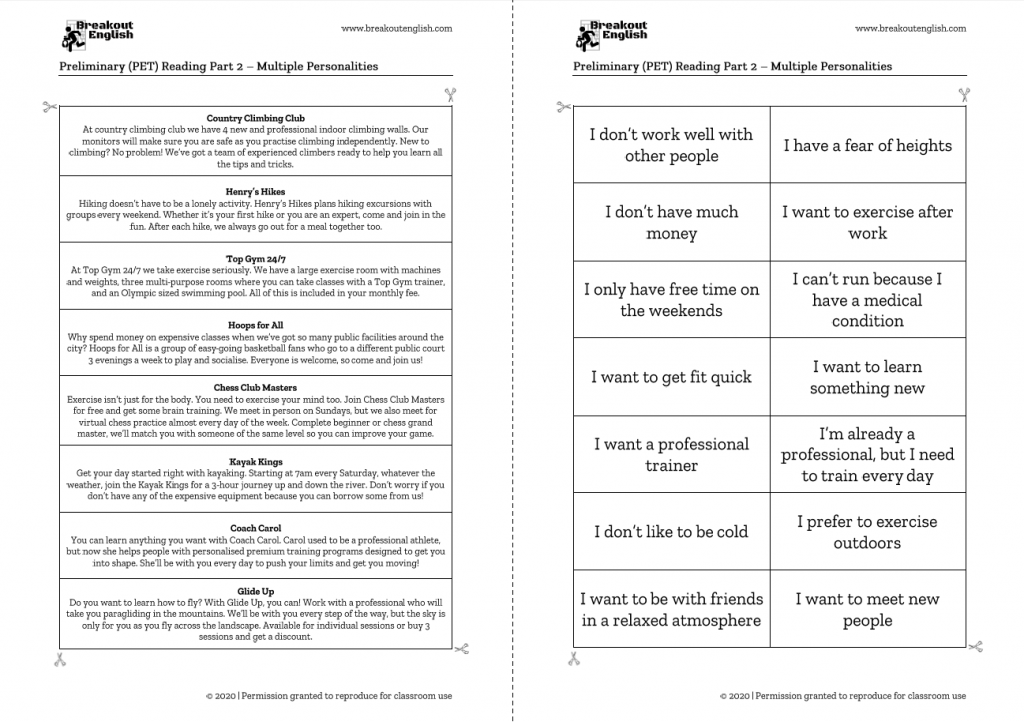Preliminary (PET) Reading Part 2 is a matching task. You are given 5 people who have to be matched to 8 different descriptions. Generally, these people are looking for an activity or product (e.g. they want to buy a book, they want to join a club etc). The activity or product will always be within the same category. For example, if they are looking for a book, the descriptions won’t include films, television or other media. The trick to this part of the exam is knowing the task. There is a very specific way the tasks are designed, which once you understand it, will make the matching task easier and faster.
At the end of this post, we’ve got some useful materials for training how to do PET Reading Part 2.

Contents
How is Preliminary (PET) Reading Part 2 designed?
The fundamental key for Preliminary Reading Part 2 is understanding it’s design. There are always five people interested in the same thing, but they all have 2-3 specific criteria that have to be met. Meeting all of these criteria is essential.
For example, imagine we need to find a book for Paul to read:

That seems simple enough. Get Paul a science fiction book, right? But there will likely be more than one science fiction book to choose from in the eight options. So what are Paul’s three criteria?
- Science fiction
- Cheap
- Not a bestseller
The correct answer will only be the book that meets all three of those criteria. A famous book from the library is not for Paul because it doesn’t meet criteria 3. Likewise, a rare and priceless first edition book about an alien invasion doesn’t meet criteria 2.
This is where vocabulary knowledge of synonyms and antonyms will be useful. The tasks are almost never written with exactly the same vocabulary in the question text and answer text. In fact, if there is a word that is exactly the same in both texts, be suspicious. Often these are distractors placed in the text to make you choose the wrong answer.
Recommended technique for Preliminary (PET) Reading Part 2
Many of my students rush the reading tasks in the exam. There is a lot to do and only 45 minutes to do it. However, rushing Reading Part 2 is a bad idea. With the right technique, it can be done quickly, but it’s important not to skip over the details.
STEP 1 – IDENTIFY
Identify the three criteria for one person. You can do this by underlining, highlighting or making a simple list like the one we did above for Paul.
STEP 2 – SCAN
Read through the eight options and mark any that meet the criteria. You may want to underline, highlight or write the letter of the text next to your list. Don’t worry about understanding every word in every text. Move through the texts quickly and scan for your criteria.
STEP 3 – DETAILED READING
You may have more than one text which feels correct. This is when you need to focus on more detail. Which text specifically meets the criteria? Are there any distractors that are tricking you to make you choose the wrong text? Which text meets the criteria best? Once you’ve answered these questions, you should be able to choose your final answer.
STEP 4 – REPEAT
Rinse and repeat the three steps for each person. Don’t forget to scan the answers you already chose for every person because you may need to change an answer.
Once you’ve done a few exercises like this, it becomes mechanical. A strong B1 exam candidate should be abe to complete this task in 5-10 minutes.
The materials – Multiple personalities
The materials on this page approach PET Reading Part 2 from a different angle than simply completing an exam task. You have a selection of criteria, all separated individually, and eight texts. The criteria can be mixed and combined to create people, who are then matched to the texts. The purpose of the task is to aid analytical skills by forcing students to notice individual criteria. By allowing the students to create their own people, it personalizes the task and makes them more invested.
Here’s the recommended procedure for classroom use.
Procedure
- Introduce the topic, healthy activities. Ask students what they do to stay fit and healthy or if they are part of any groups or clubs.
- Give students the eight texts of different activities and have student discuss which ones they like. You could give all of the student all of the texts, or you could cut them up and have students focus on one or two activities, which they then share with the others in class.
- The people criteria are then distributed to students to match to the activities. At first, tell them to match one criteria to one activity and let them see how easy that is.
- Tell the students that they are going to create five people. In pairs or groups they combine the criteria. To extend this section, you could make students rewrite the criteria as a single paragraph using basic linking words. Extra points if they give their person a name or find a picture of them.
- Students then have to match the created people to the eight texts. This time they will notice it is harder to match and less options are available. They can then rotate their people and repeat the task until everyone has the best option.
- I recommend following up from this task with an authentic Preliminary (PET) Reading Part 2 either as homework or with further analysis in class.
EXAM PART: Reading
EXAM SKILLS: Detailed comprehension of factual material
TIME: 30 minutes +
PREPARATION: One copy of the worksheet per student
Download





Thank you for the good activities / materials.